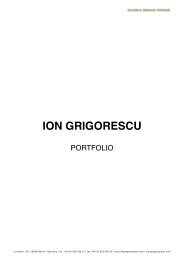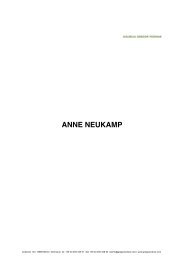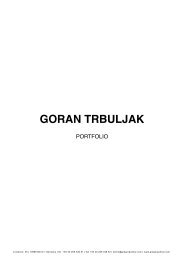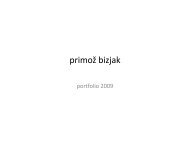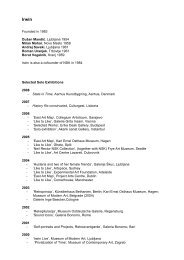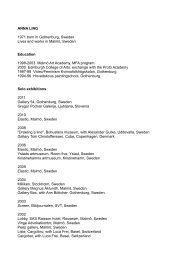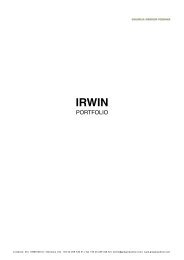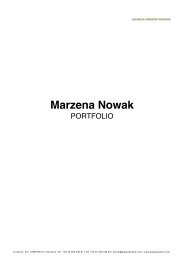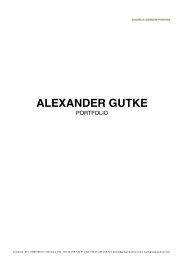ATTILA CSÖRGŐ - Galerija Gregor Podnar.
ATTILA CSÖRGŐ - Galerija Gregor Podnar.
ATTILA CSÖRGŐ - Galerija Gregor Podnar.
Create successful ePaper yourself
Turn your PDF publications into a flip-book with our unique Google optimized e-Paper software.
<strong>ATTILA</strong> <strong>CSÖRGŐ</strong><br />
PORTFOLIO<br />
Lindenstr. 35 | 10969 Berlin | Germany | tel. +49 30 259 346 51 | fax +49 30 259 346 52 | berlin@gregorpodnar.com | www.gregorpodnar.com<br />
!
The work Magnet Spring is composed of<br />
twelve panes of glass held together vertically<br />
by numerous magnets, letting the hockey<br />
puck-shaped magnets to seemingly float in<br />
the air.<br />
Magnet Spring<br />
Glass panels, magnets, 100 x 100 x 100 cm, 1991<br />
!
For the work Drawing Machine Csörgő again<br />
employs magnetic forces. Hidden by metal<br />
cuttings, a magnet draws its path on a pane<br />
of glass, powered by a turntable beneath the<br />
plate covered with cuttings<br />
Drawing Machine<br />
Magnets, record player, glass plate, metal powder, 100 x 100 x 20 cm, Ed. of 3, 1992<br />
!
Exhibition view at Ludwig Museum, Budapest, 2009 (version with 9 balls, not available anymore)<br />
Within a square-shaped area, white solids of paper float above »paper<br />
turbines«. When creating these solids, I began with forms, which can be<br />
inscribed within a sphere, such as regular and semi-regular geometrical<br />
solids. At the same time, I used some concepts – such as approaching<br />
the sphere from the point of view of a spiral, as if peeling an orange<br />
(quasi transformation form childhood). When I began working on this, I<br />
was interested in the a priori incompatibility between two seemingly<br />
related systems: plane geometry and solid geometry. While certain<br />
forms may be conveniently created from a plane – for instance, the<br />
creation of the cube suggests compatibility between plane and space –<br />
attempts to “flatten” a sphere reveal the ultimate contradiction between<br />
the two systems. Although the problem is an abstract one, it frequently<br />
arises in everyday life. In an atlas, for example, distortions resulting from<br />
the projection mean that area of Greenland may appear equivalent to<br />
that of Africa. While the cartographer attempts to flatten the globe, my<br />
aim was different, in that I was attempting to create by gluing together<br />
sheets of paper. I was working on the hypothesis that a sphere will float<br />
motionlessly above an electric fan. My efforts to construct a sphere form<br />
a plane could only result in a variety of imperfect approximations. When<br />
placed in the air stream, these “aberrations” are set in motion as the air<br />
catches their facets and vertices. These results in various forms of<br />
motion – the solids rotate, float and bounce in the air stream, sometimes<br />
capriciously, sometimes more evenly, depending on their structure.<br />
How to Construct an Orange?<br />
6 paper balls and 6 electronic fans, Spherical form: 15 cm in diameter each, variable dimensions, 1993 - 2002<br />
!
How to Construct an Orange?<br />
Lambda-print on photo-paper, 90 x 130 cm, ed. 4/5, 1993 - 2002<br />
!
Details from Untitled (1 tetrahedron+1 cube+1 octahedron = 1 dodecahedron)<br />
Platonic Constructions<br />
Wooden sticks, strings, pulley wheel, iron frame, electromotor, five different versions, 1997-2000<br />
!
View of Untitled (Dodecahedron contra icosahedron)<br />
!
Exhibition view at Domaine de Kerguéhennec, France, 2009<br />
The Hemisphere is produced by two synchronized revolutions, that is, a revolving element rotated around an axis.<br />
The speed of the two revolutions and the “density” of the spiraling hemisphere are determined by the relation<br />
between the two speeds. The two revolutions occur in planes forming a 45-degree angle.<br />
The construction is based on a motor-driven, heavy disc (revolution 1), on the edge of which there is a device<br />
which rotates a thin metal rod (revolution 2). The rod is fitted with a small light bulb at each end, which, according to<br />
the geometrical relationship between the rod and the disc, is only able to describe a hemisphere. The hemisphere<br />
forms a dome-shaped cover over the construction by which it has been created, while the construction, due to the<br />
dark background and the speed of rotation, becomes practically invisible. The spiraling hemisphere, of course,<br />
does not appear to the naked eye as it appears on the photo, since the image is the result of the interaction of two<br />
machines, (the construction and a long exposure camera). What is actually visible to the spectator are two rays of<br />
light spiraling up and down, describing a widening and narrowing movement while changing place with each other.<br />
The rays obviously follow a curved surface, which, after a short period of observation, can be identified as a<br />
hemisphere.<br />
Hemisphere<br />
5 Iflo-flex photographs, 30 x 24 cm each, ed. of 10 + 2 AP, 1996<br />
!
Stagnant and spinning phases<br />
The series "Occurrence Graphs" is based on the interference of mutually co-operating graphs.<br />
There are two black discs with transparent graphs on them. The discs partly cover each other and together create a<br />
common area in the shape of a plum-pit which only allows the light of the lamp positioned behind the discs to show<br />
through when the two graphs intersect. The system can be induced into motion with the aid of an electric motor. It<br />
is then revealed that in a switched-off position the intersections of the visible and seemingly disordered graphs<br />
without any regular shape follow a regular geometrical pattern (e.g., in the form of a triangle, circle, infinity sign,<br />
et.).<br />
Thus, this phenomenon is of double, or more precisely, two times double nature. One graph can function together<br />
with another (i.e., its pair on the other disc). The nature of this function is revealed only when the graphs start<br />
functioning together in a spinning motion. This, however, results in a rather different condition. The stable and<br />
seemingly disordered image that is visible when the discs are not moving thus becomes virtually stable and<br />
explicitly ordered only when in motion.<br />
Occurence Graph II<br />
Lamp, fiberglass disc, celluloid film, electric motor, spinning components, 67 x 35 x 23 cm, ed.of 2, 1998<br />
!
Spherical Vortex III / I<br />
Spherical Vortex is the path of a flashlight bulb made by connecting three separate whirling movements of different<br />
velocity. Starting from a single point, the light-source makes a spiral of growing radius, describing a 'sphere'.<br />
Having reached its final limit, the light spirals back into a point-source state. Parallel to the exhibition of the moving<br />
device, 4 photos are on display, which were made with different exposures (consecutive or long exposure),<br />
revealing the path of light that is invisible to the naked eye.<br />
Spherical Vortex, 1999 – 2002<br />
Spherical Vortex I: Electronic torch bulb, rotating part, engine. Sphere diameter: 0-30 cm, complete structure: 80 x<br />
40 x 50 cm + four C-Prints, 44 x 44 cm each<br />
65.000,- EUR+ VAT<br />
Spherical Vortex II: Three Ilo-flex photographs, 44 x 44 cm each, Ed. of 10 + 2 AP<br />
Spherical Vortex III: Three Ilo-flex photograph, 128 x 128 cm each, Ed. of 3 + AP each<br />
!
Spherical Vortex III / II Spherical Vortex III / III<br />
Exhibition view at Domaine de Kerguéhennec, France, 2009<br />
!
Photomontage: proposal for the installation (Cut paper's piece under glass panel)<br />
Peeled City II<br />
Cut paper (floor piece), drawing (pencil on millimeter paper), 5 sketches and a series of 15 C-prints, 2002<br />
!
Cut paper (floor piece), colored paper, tape, pencil, approx. 400 x 250 cm<br />
Five from the series of 15 C-prints, 20 x 20 cm each (unframed size), framed in three frames<br />
!
One of the five sketches framed together (detail)<br />
Drawing on millimeter paper and detail<br />
!
Exhibition view at Domaine de Kerguéhennec, France, 2009<br />
The works of the Orange-Space series of Attila Csörgő consist of twin photographs of a 360° panoramic photo<br />
shot, the first two-dimensional image displayed in a frame in form of a peeled orange, the second one as a<br />
spherical image on a thin aluminium stand constructed from the first pre-given form.<br />
Orange Space<br />
Black-and white spirally shaped photo stripes presented in two stages: Two-dimensional images, 50 x 130 cm and<br />
spherical images, 20 cm in diameter. 2003-2005<br />
!
Orange Space (Amsterdam)<br />
View of the peeled Orange Space (Amsterdam)<br />
!
Peeled Still Life I<br />
Paper, tape, 30 x 30 x 20 cm (sculpture), 120 x 150 cm (framed cut paper), 2008<br />
!
Möbius Space<br />
Installation view at <strong>Galerija</strong> <strong>Gregor</strong> <strong>Podnar</strong>, 2009<br />
Looped transparency, ca. 25 x 15 x12 cm, flat photo stripe, B&W print, 70 x 11 cm, light table, 2006<br />
Each set of one transparency and one photograph is unique<br />
!
Möbius Space (Kersuzan I)<br />
Möbius Space (Kersuzan II)<br />
Möbius Space (Kerguehennec I)<br />
Views of the flat photo strip of the different versions<br />
!
Views of the camera (unique photographic device made for the Moebius Space project)<br />
The camera used by Attila Csörgő for Moebius Space is the third device he has constructed. In contrast to the first<br />
two, it is a slit camera, in which light reaches the photosensitive surface through a very narrow slit. The result is that<br />
both the camera and the “film” move during the exposure of an image. His previous devices included the camera<br />
for Semi Space, which exposed its image on a transparent hemisphere coated in emulsion; the entire circle<br />
becomes its perimeter. Orange Space employs a sheet of photographic paper assembled into a roughly spherical<br />
shape for this purpose, which serves as the “negative” for the contact positive prepared using it. The effect here is<br />
as if the visual space around us has been turned inside out, appearing as one sole image on the sphere within the<br />
camera, made possible by the cameraʼs turning in many directions.<br />
We see the image of Moebius Space on transparency film, which only seems to resemble a traditional panorama.<br />
To understand the real difference, we must know what a Moebius strip is: if we take a strip of paper, twist one end<br />
in a half-turn, and glue the ends together, we get such a strip; you can draw a line on it – without ever lifting the<br />
pencil from the paper – whose “ends” will meet. This form, turning in space, is in fact one-sided, with only one<br />
edge. Or to use the proper language of geometry and topology textbooks, it is a real projective plane in which there<br />
is one hole.<br />
The photograph recorded on the transparent Moebius plane is a special, inside-out round panorama. The same<br />
motif appears on the stripʼs two ends – upside-down on one of them – that fit together perfectly with a 180-degree<br />
twist. Due to the light-scan of the slit camera, this Moebius photographic space is no snapshot. It is created over a<br />
given span of time, and the resulting image, joined at the ends, can be seen as a plastic form with as many<br />
perspectives as we can view it from. Whatever our approach, it is a situation full of paradox that the piece is<br />
simultaneously one, two, and three-dimensional, depending on whether we are trying to interpret the surface that<br />
bears the image, the photograph itself, or the manner in which it is exhibited. A recognition of this ambivalence,<br />
while not absolutely essential, might help us to understand the unusual spatial situation that this image presents.<br />
Excerpt from Attila Csörgő and Moebius Space, Miklós Peternák, 2008<br />
!
Photo Labyrinth<br />
View at Museum Folkwang im RWE Turm, Essen, Germany, 2008<br />
Photo Labyrinth, view from the camera Illuminated die for the photo shooting<br />
Wooden construction, glass pane, one camera, mirrors, 500 x 500 x 500 cm, 2007<br />
!
Photo Labyrinth / Trajectory Dice (small)<br />
Lambda-print on wooden cubes, Set of 7 different cubes, 20 x 20 x 20 cm each, ed. of 4 + AP, 2008<br />
!
View at Domaine de Kerguéhennec, France, 2009<br />
Photo Tower<br />
Aluminum construction, glass pane, 6 cameras, 400 x 400 x 400 cm, 2007<br />
!
Photo Tower / Trajectory Dice (large)<br />
Lambda-print on wooden cube, 60 x 60 x 60 cm, ed. of 4 + AP, 2008<br />
Photo Tower / Trajectory Reconstruction<br />
3D print, synthetic resin, 31 x 50 x 5 cm, ed. of 4 + AP, 2008<br />
!
View of Photo Tower outside Artist throwing the dice (view from below)<br />
Exhibition view at Domaine de Kerguéhennec, France, 2009<br />
!
"Clock Work" consists of an irregular shape “sculpture” with a tickling arm programmed by a device that is<br />
synchronized with the actual time second by second.<br />
At the same time, two projections on the wall show the sculpture from two different points of view, producing two<br />
one-arm clocks: one circular, the other in the form of an infinite sign.<br />
Here, the artist plays with the concept of time. The clock is the tool for measuring and presenting time, whereas the<br />
images work on a more abstract level. There are different representations of time. One of these is the circular<br />
motion, which implies a repeating cycle in time. Another is the concept of time as infinite, represented by the infinite<br />
sign. There are also two opposite ideas; the movement, which is relative to time and change; and the geometric<br />
figures, which are amongst the most static objects created by man.<br />
Clock Work<br />
Mixed media (metal, wood, light projections, engine), variable dimension, 2011<br />
!
Visualization of the metallic sculpture with both shapes: infinite sign and circle<br />
Clock Work<br />
Mixed media (metal, wood, light projections, engine), variable dimension, 2011<br />
!
Exhibition views at Secession, Vienna, 2011<br />
Clock Work Drawings<br />
Pencil on paper, 29,7 x 21 cm each, series of 11 drawings (1 frame with 1 drawing, 2 frames with 3 drawings, 1<br />
frame with 4 drawings), 2011<br />
!
Pittura Grande<br />
Silver print, 80 x 68 cm, ed. of 8 + 2AP, 1993<br />
!
Landscape<br />
Silver print, 25 x 36 cm, ed. of 8 + 2AP, 1993<br />
!
Two Oranges<br />
C-Print, 26 x 40 cm, ed. of 8 + 2AP, 1994<br />
!
The photographic work shows a sculpture resulting from the filling up of the empty spaces of a Swiss cheese with<br />
resin.<br />
Inner Space<br />
C-Print, 26 x 26 cm, Ed. 1/8 + 2 AP, 1997<br />
!
Perspective Dice<br />
Wooden sculpture, 17 x 28 x 3 cm, unique, and lambda print, 34 x 78 cm, ed. of 8 + 2 AP, 1992-2009<br />
!
Football World Map<br />
Etching, 53,5 x 76 cm, ed. of 8 + 2AP, 2004<br />
!
Make Love<br />
C-print, framed, 80 x 80 cm, ed. of 8 + 2AP, 2005<br />
!
Epiciklos<br />
C-Print, framed, 80 x 80 cm, ed. of 8 + 2 AP, 2005<br />
!
Peeled City I<br />
12 C-Prints, 20 x 20 cm each in three frames, ed. of 8 + 2AP, 2002<br />
Peeled City II<br />
14 C-Prints, 20 x 20 cm each in two frames, ed. of 5 + 2 AP, 2002<br />
!
Inner Spaces I-V<br />
5 B&W Prints (framed), 30 x 126 cm, ed. of 5 + 2AP, 1995-2000<br />
Peeled Cube II<br />
7 B&W Print (framed), 20 x 117 cm, ed. of 5 + 2AP, 1995-2001<br />
!
<strong>ATTILA</strong> <strong>CSÖRGŐ</strong><br />
Born 1965 in Budapest<br />
Lives and works in Budapest<br />
Education<br />
1988-94 Academy of Fine Arts, Budapest (painting / inter-media faculty)<br />
1993 Rijksakademie van beeldende Kunsten, Amsterdam<br />
Selected solo exhibitions<br />
2011<br />
Secession, Vienna, Austria<br />
Archimedean Point, Hamburger Kunsthalle - Galerie der Gegenwart, Hamburg, Germany<br />
2010<br />
Archimedean Point, MUDAM, Musée d´Art Moderne Grand Duc Jean, Luxemburg<br />
2009<br />
Archimedean Point, Ludwig Museum, Museum of Contemporary Art, Budapest, Hungary<br />
Domaine de Kerguéhennec, France<br />
<strong>Galerija</strong> <strong>Gregor</strong> <strong>Podnar</strong>, Berlin<br />
2008<br />
Wurfelbahnen und Raumkurven Museum Folkwang im RWE Turm, Essen, Germany<br />
2007<br />
Platonic Geometry, Galeria Arsenal, Bialystok, Poland<br />
Szent István Király Múzeum, Székesfehérvár, Hungary<br />
2006<br />
Galleria Contemporaneo, Mestre–Venice, Italy<br />
Skin of Space, <strong>Galerija</strong> <strong>Gregor</strong> <strong>Podnar</strong>, Ljubljana, Slovenia<br />
!
2005<br />
Gallery Van Zoetendaal, Amsterdam, The Netherlands (with Gábor Ősz)<br />
2004<br />
Platonic love, Kettles Yard, University of Cambridge, UK<br />
Orange Space, acb Gallery, Budapest, Hungary<br />
2002<br />
Peeled City, Art in General, New York, USA<br />
Semi-Space, Budapest Galéria, Budapest, Hungary<br />
2001<br />
Le Fresnoy Studio national des arts contemporains, Tourcoing, France<br />
2000<br />
Galerie für Gegenwartskunst Barbara Claassen-Schmal, Bremen, Germany<br />
Laqua Obliqua, Fioretto Arte Contemporanea, Padua, Italy<br />
1999<br />
Altered States, <strong>Galerija</strong> Škuc, Ljubljana, Slovenia (with Antal Lakner)<br />
Galeria Monumental, Lisbon, Portugal (with Endre Koronczi)<br />
1996<br />
Stúdió Galéria, Budapest, Hungary<br />
1994<br />
Three Solids, Óbudai Pincegaléria, Budapest, Hungary<br />
Selected group exhibitions<br />
2012<br />
Documeta 13, Kassel, Germany<br />
2011<br />
Wir sind alle Astonauten, MARTa Herford, Germany; traveling to Zeppelin Museum, Friedrichshafen, Germany<br />
(2012)<br />
Seeing Things, Kleine Humboldt Galerie, Berlin, Germany<br />
Galerie Poggi & Bertoux Associés, Paris, France<br />
2010<br />
Donumenta 2010: Aktuelle Kunst aus Ungarn, Kunstforum Ostdeutsche Galerie, Regensburg, Germany<br />
The Promises of the Past, Centre Pompidou, Paris, France<br />
Fine Line, Georg Kargl Fine Art & Georg Kargl Box, Vienna, Austria<br />
What Happens if?, Storey Galery, Lancaster, UK<br />
Galerie Schleicher+Lange, Paris, France (in the framework of Berlin-Paris, an exchange of galleries)<br />
2009<br />
MUDAM, Musée d´Art Moderne Grand Duc Jean, Luxemburg<br />
Materialen, Muenzsalon, Berlin, Germnay. Curated by Birte Kleemann<br />
Galleria Enrico Astuni, Bologna, Italy<br />
2008<br />
Revolution – Forms that turn, 16th Biennial of Sydney, Australia<br />
Reykjavik Experiment Marathon, Reykjavik Art Museum – Hafnarhus. Island. Curated by Hans Ulrich Orist and<br />
Olafur Eliasson<br />
!
2007<br />
What You See Is What You Guess, FRAC Champagne-Ardenne, Reims, France<br />
Time flies, gb agency, Paris, France<br />
Fuori Uso 2006, National Museum of Contemporary Art, Bucharest, Romania<br />
2006<br />
Cosmogonies, La Galerie, Noisy-le-Sec, France<br />
Und es bewegt sich…, Museum Bochum, Germany<br />
Venture II, <strong>Galerija</strong> <strong>Gregor</strong> <strong>Podnar</strong>, Ljubljana, Slovenia<br />
Fuori Uso, Are you experienced?, Ex Mercato Ortofrutticolo, Pescara, Italy<br />
2005<br />
Nach Rokytník. Die Sammlung der EVN, Museum of Modern Art Foundation<br />
Ludwig, Vienna, Austria<br />
Minimalism and After IV, New Acquisitions of the DaimlerChrysler Collection, Haus Huth, Berlin, Germany<br />
Active Image, National Centre for Contemporary Art, Moscow, Russia<br />
Light, Image, Illusion, 3 Aegina Acadamy, Aegina, Greece<br />
Bewegliche Teile / Moving Parts, Museum Tinguely, Basel, Switzerland<br />
Nothingness, <strong>Galerija</strong> <strong>Gregor</strong> <strong>Podnar</strong>, Kranj / Ljubljana, Slovenia<br />
2004<br />
Travelling without Moving, W139, Amsterdam, The Netherlands<br />
4 Artists from Hungary, Tanja Rumpf Gallery, Haarlem, The Netherlands<br />
Bewegliche Teile / Moving Parts, Kunsthaus Graz, Austria<br />
Nothingness, Galerie Eugen Lendl, Graz, Austria<br />
Soap oper, Kunsthalle, Budapest, Hungary<br />
Breakthrough, Grote Kerk, Den Haag, The Netherlands<br />
Venture, <strong>Galerija</strong> <strong>Gregor</strong> <strong>Podnar</strong>, Kranj / Ljubljana, Slovenia<br />
Persistante perspective, Ecole Superieure des Beaux-arts de Mans, Le Mans, France<br />
2003<br />
Poetic Justice, 8th Istanbul Biennale, Istanbul, Turkey<br />
Modesty, <strong>Galerija</strong> Škuc / Moderna galerija, Ljubljana, Slovenia<br />
2002<br />
the eye of the beholder, Dundee Contemporary Arts, UK<br />
Twinklings, <strong>Galerija</strong> Škuc, Ljubljana, Slovenia<br />
2001<br />
Milano Europe 2000, Palazzo della Triennale, Milan, Italy<br />
Geologists at Sunset, Hotelit, Fort Asperen, Acquoy, The Netherlands<br />
2000<br />
Uncontrolled, North Exhibitionspace, Copenhagen, Denmark<br />
Intuition, innovation, invention, Kunsthalle, Budapest, Hungary<br />
What, how & for whom, Dom HDLU, Zagreb, Croatia<br />
After the Wall, Ludwig Múzeum, Budapest-Hamburger Bahnhof, Berlin, Germany<br />
Change of Order, National Gallery in the Trade Fair Palace, Prague, Czech Republic<br />
Germination 6, Ludwig Forum für internationale Kunst, Aachen, Germany<br />
1999<br />
Tackling Techné, 48. Venice Biennial, Hungarian Pavillion, Italy<br />
Kunst der neunziger Jahren in Ungarn, Akademie der Künste, Berlin, Germany<br />
After the Wall, Moderna Museet, Stockholm, Sweden<br />
1998<br />
Obserwatorium, Centre for Contemporary Art, Ujazdowski Castle, Warsaw, Poland<br />
Inter/Media/Art, Ernst Múzeum, Budapest, Hungary<br />
!
Jenseits von Kunst, Museum van Hedendaagse Kunst, Antwerpen, Belgium<br />
1997<br />
Schwerelos Skulpturen, Landesgalerie am OÖ. Landesmuseum, Linz, Austria<br />
Ludwig Múzeum, Budapest, Hungary<br />
Sexmachine, Stúdió Galéria, Budapest, Hungary<br />
1996<br />
The Butterfly Effect, Kunsthalle, Budapest, Hungary<br />
3x3 from Hungary, Bard Collage, Annandale-on-Hudson, New York, USA<br />
Beyond Art, Ludwig Múzeum, Budapest - Neue Galerie, Graz, Austria<br />
Multilingual Landscapes, Contemporary Art Center, Vilnius, Lithuania<br />
Computer World, The Tannery, London, UK<br />
1995<br />
Zusammenziehende Häuser, Kunsthaus, Hamburg, Germany<br />
In and Out of Touch, Budapest Galéria – Haus Ungarn, Berlin, Germany<br />
1994<br />
22. Biennial of Sao Paulo, Sao Paulo, Brazil<br />
1992<br />
Space Concepts, Budapest Galéria, Budapest, Hungary<br />
Award & Residencies<br />
2011 Atelier Calder, Saché, France<br />
2008 Nam June Paik Award, Kunststiftung NRW, Cologne, Germany<br />
Collections (selection)<br />
MUDAM, Musée d´Art Modern Grand Duc Jean, Luxemburg<br />
Center for Contemporary Art / Ujazdowski Castle, Warsaw, Poland<br />
DaimlerChrysler AG, Stuttgart, Germany<br />
EVN Sammlung, Maria Enzersdorf, Austria<br />
Institute of Modern Art, Dunaujvaros, Hungary<br />
Ludwig Museum, Budapest, Hungary<br />
Robert Bosch, Repräsentanz Berlin, Germany<br />
!



